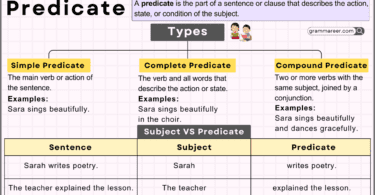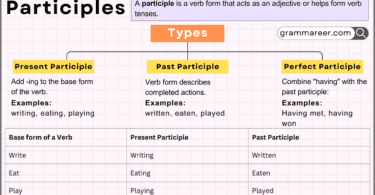Reflexive pronouns are used when the subject and the object of a sentence are the same. In other words, they are used when someone does something to themselves. Reflexive pronouns always end in “-self” (singular) or “-selves” (plural).
Table of Contents
Definition
Reflexive pronouns are pronouns that refer back to the subject of a sentence. They are used when the subject does something to itself.
List of Reflexive Pronouns
- Myself
- Yourself (singular)
- Himself
- Herself
- Itself
- Ourselves
- Yourselves (plural)
- Themselves
Examples of Reflexive Pronouns
- I made this cake myself.
- She looked at herself in the mirror.
- He hurt himself while playing soccer.
- We enjoyed ourselves at the party.
- They taught themselves to play guitar.
- The cat cleaned itself after eating.
- You should take care of yourself.
- We fixed the problem by ourselves.
- You all should prepare yourselves for the exam.
- He introduced himself to the new class.
Personal Pronouns and Their Reflexive Forms
Personal pronouns are words we use to talk about people or things without naming them directly. Reflexive pronouns refer back to the same person or thing that the personal pronoun mentions.
| Personal Pronoun | Reflexive Pronoun |
|---|---|
| I | myself |
| You | yourself |
| He | himself |
| She | herself |
| It | itself |
| We | ourselves |
| They | themselves |
Usage of Reflexive Pronouns
Reflexive pronouns are used for different reasons. The key thing to remember is that they always refer back to the subject. Here’s how to use them:
1. Emphasizing the Subject
Reflexive pronouns are used to add emphasis and show that the subject of the sentence did the action alone.
- He fixed the car himself.
- We cleaned the house ourselves.
2. When the Subject and Object Are the Same
Reflexive pronouns are used when the subject of the sentence does something to itself.
- I taught myself how to play the piano.
- She talks to herself when she’s stressed.
3. To Show Emphasis
Reflexive pronouns can also be used to show that the action was done without help.
- He built the desk himself.
- She solved the puzzle herself.
Common Errors When Using Reflexive Pronouns
Even though reflexive pronouns are simple, they are sometimes used incorrectly. Here are some common mistakes to avoid:
1. Incorrect Use of Reflexive Pronouns
Reflexive pronouns should only be used if the subject and object are the same. For example, “He gave the book to myself” is incorrect. The correct sentence is, “He gave the book to me.”
2. Unnecessary Use for Emphasis
Don’t use reflexive pronouns for emphasis unless it is needed. For example, “I, myself, am going to the store” is only correct if you want to add emphasis.
Key Rules to Remember
- Always Refers to the Subject: Reflexive pronouns must always refer back to the subject of the sentence.
- Not for Regular Actions: Reflexive pronouns are used when the subject is doing something to itself. For example, you wouldn’t say, “He eats himself lunch.” You would just say, “He eats lunch.” The reflexive pronoun is not needed in this case.
- No Repetition of Subject: If the subject and object are the same, use a reflexive pronoun to avoid repetition.
- Use for Emphasis: Reflexive pronouns can also be used to show that someone did something alone or without help. This is called intensive use.
Read More






